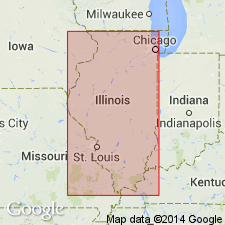
- Usage in publication:
-
- Clore formation
- Modifications:
-
- Named
- Dominant lithology:
-
- Limestone
- Shale
- AAPG geologic province:
-
- Illinois basin
Summary:
Named Clore formation. Consists of limestone more than 30 ft thick. Transition beds at base, as much as 25 ft thick, consist of arenaceous and calcareous shale with some limestone beds. Topmost formation of Chester series at this place. Underlain by Palestine sandstone.
Source: GNU records (USGS DDS-6; Reston GNULEX).
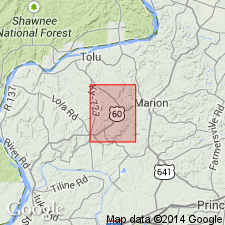
- Usage in publication:
-
- Clore Limestone*
- Modifications:
-
- Overview
- AAPG geologic province:
-
- Illinois basin
Summary:
Designated Clore Limestone in westernmost KY. Upper 30+/-ft is shale and limestone. Shale is dark gray, calcareous, contains some limestone. Limestone is dark gray, dense, argillaceous; in beds 3 to 4 in. thick; large insoluble content locally produces a secondary chert residuum. Rarely exposed. Middle 10+/-ft is siltstone, greenish-gray, thin-bedded, locally shaly; rarely exposed. Lower 65-85 ft is shale and limestone. Shale is dark gray, locally silty, commonly calcareous. Limestone is medium to dark gray, finely crystalline, argillaceous; high insoluble content; fossiliferous in places; locally dolomitic. Locally basal few feet is siltstone containing abundant calcareous fossil fragments. Rarely exposed. Underlain by Palestine Sandstone; overlain by Degonia Sandstone.
Source: GNU records (USGS DDS-6; Reston GNULEX).
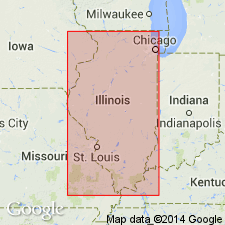
- Usage in publication:
-
- Clore Formation
- Modifications:
-
- Overview
- AAPG geologic province:
-
- Illinois basin
Summary:
Current (1975) usage of Illinois Geological Survey is Clore Formation. Includes three members, a lower limestone and shale member (Cora), a middle sandstone and shale member (Tygett), and an upper limestone and shale member (Ford Station). Occurs in southern part of IL. It is 40-60 ft thick near its northern and northwestern limits and thickens to 120 ft at its southern limit. Underlain by Palestine Sandstone; overlain by Degonia Sandstone. Isopach map included.
Source: GNU records (USGS DDS-6; Reston GNULEX).
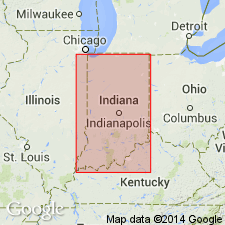
- Usage in publication:
-
- Clore Limestone
- Modifications:
-
- Overview
- Revised
- AAPG geologic province:
-
- Illinois basin
Summary:
Current (1986) usage of Indiana Geological Survey is Clore Limestone of Buffalo Wallow Group. Restricted to subsurface use. Detailed description and reliable thicknesses are not available. Overlies Palestine Sandstone; underlies Degonia Sandstone.
Source: GNU records (USGS DDS-6; Reston GNULEX).
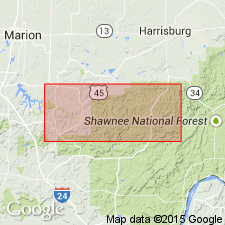
- Usage in publication:
-
- Clore Formation
- Modifications:
-
- Overview
- AAPG geologic province:
-
- Illinois basin
Summary:
Clore Formation in the study area is subdivided into (ascending) Cora, Tygett Sandstone, and Ford Station Members of Swann (1963). Unit can be correlated in outcrop and subsurface throughout southern IL. Well records show that thickness ranges from 95 to 120 ft in the Eddyville and Stonefort quads, and from 110 to 155 ft in the Creal Springs quad. Cora Member (35 to 70 ft thick) consists of shale and thin limestone beds. Tygett Sandstone Member ranges from less than an inch to 20 ft thick in the Eddyville quad and from 15 to 50 ft thick in the Stonefort and Creal Springs quads. Tygett consists mostly of gray silty shale and siltstone to the east, but westward becomes a very fine to fine-grained sandstone. Ford Station Member consists of 23 to 50 ft of interbedded shale and limestone. Conformably overlies the Palestine Sandstone and conformably underlies the Degonia Formation. Age is Chesterian.
Source: GNU records (USGS DDS-6; Reston GNULEX).
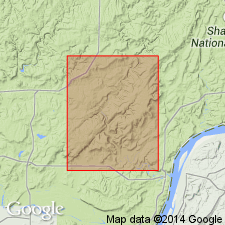
- Usage in publication:
-
- Clore Formation
- Modifications:
-
- Revised
- AAPG geologic province:
-
- Illinois basin
Summary:
The Pope Group, here revised from Megagroup and apparently reinstated, comprises strata from the base of the Aux Vases Sandstone to the top of the Kinkaid Formation, which includes the Clore Formation. According to authors, "The Pope Group is a lithostratigraphic unit distinct from its chronostratigraphic counterpart, the Chesterian Series." The lower boundaries of the two differ slightly. The group is about 1,425 ft thick in the Waltersburg quad, but the lowermost formations, from the Aux Vases Sandstone up to the Fraileys Shale Member of the Golconda Formation do not crop out. This interval is 384 ft thick in the Austin Roberts No. 1 Well. [See subunit list in index portion of Pope summary record. Publication does not name the units between the Aux Vases and the Fraileys and therefore these have not been included in the list.]
Source: GNU records (USGS DDS-6; Reston GNULEX).
For more information, please contact Nancy Stamm, Geologic Names Committee Secretary.
Asterisk (*) indicates published by U.S. Geological Survey authors.
"No current usage" (†) implies that a name has been abandoned or has fallen into disuse. Former usage and, if known, replacement name given in parentheses ( ).
Slash (/) indicates name conflicts with nomenclatural guidelines (CSN, 1933; ACSN, 1961, 1970; NACSN, 1983, 2005, 2021). May be explained within brackets ([ ]).

